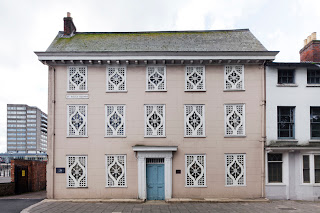This year celebrates 100 years since the birth of Ernest Urban Trevor Huddleston, who was born at 36 Chaucer Road , Bedford India Bedford Modern School , and met his future wife, Elsie
Barlow Smith in Bedford London Swindon , and then
importantly joined the Community of the Resurrection (CR) at Mirfield, becoming a monk in 1941 at the age of 28.
It was from here in 1943 that he was sent to on mission to Sophiatown in South Africa South
Africa,
Archbishop Desmond Tutu at a commemorative service at Lancing College
“I must have been about nine years of age or so, and I was standing with
my domestic worker mother on the veranda of the hostel for black blind women
for whom my mother was a cook, when a tall white man in a flowing cassock swept
past … and doffed his black hat to my mother. Only much later did I discover
that it had been Trevor Huddleston. What? A white man raising his hat to a
black woman, and an uneducated domestic worker at that? Quite unheard of in
race-obsessed South Africa South Africa 's racism declared
that each person is of infinite worth, because each is created in the image of
God … He sort of pierced the gloom of race-mad South Africa
Father Trevor met many of the leaders of the anti-apartheid movement, such as Nelson Mandela, Desmond Tutu and Oliver Tambo and became a fierce critic of segregation. Oliver Tambo applied as a Physics teacher during the early 1950’s at St. Peter’s School where Huddleston later became Superintendant and they became very close friends.
Between 1930 and 1950 Sophiatown became a symbol of unity and diversity
in what was an increasingly racially divided country. It was in this tiny
suburb that South Africans of every group co-existed in a peaceful, if chaotic
manner. It was particularly known as a centre of arts, literature, music and
drama.
During the 1950's the government began a brutal campaign against so-called 'black spots' and racially integrated areas, such as Sophiatown, became a casualty of the government's new system of forced removals under the Group Areas Act. From February 1955 Sophiatown was systematically destroyed. Only four buildings survived the removals. Neighbours and families were moved to different areas according to skin colour. The community protests led by African leaders and Trevor Huddleston, extended to
In 1955 Trevor Huddleston wrote the book “Naught for your comfort” in response to the removals that he had witnessed. He used to publicise and speak out against the atrocities being committed in
Huddleston was elected President of the Anti-Apartheid Movement in 1981. He criticized white liberalism, arguing that it had "done so much to keep the apartheid structure in place . . . by its essential philosophy of evolutionary change." Some people regarded him as a radical and combative man, but Huddleston crucially led the move for economic sanctions against
Archbishop Trevor Huddleston's gave a speech at the 1990 Nelson Mandela: An International tribute to free South Africa concert held on the 16th April at Wembley stadium, London. This celebrated Nelson Mandela’s freedom after he was freed from prison on the 23rd February 1990 after 27 years.
The bust for Huddleston was sculpted by Ian Walters and was bought for Bedford Bedford as
he came from Bedford , as well as honouring the
work of many people in Bedford from hundreds of
local people. The bust unveiled in 1999 was re-dedicated by Nelson Mandela during
his visit to Bedford
The plinth is engraved with Nelson Mandela’s own words “No white person has done more for South Africa than Trevor Huddleston”, is a worthy tribute to a great campaigner and a life spent serving, but also fighting for the freedom of others.
This year is the 100th anniversary of Sophiatown. The Trevor
Huddleston CR Memorial Centre are launching the Sophiatown 100: Motswako
celebration. Find out more at www.trevorhuddleston.org
For more information see:
Naught for Your Comfort, by Trevor Huddleston
Trevor Huddleston a Life, by Robin Denniston
Lancing College: Click here for the Full Sermon by Archibishop Desmond Tutu
There is a live Radio 4 interview with Archbishop Trevor Huddleston from 1988 talking about his life and work to that date see BBC Radio 4 interview
By Lydia Saul, Keeper of Social History











